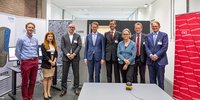State secretary Dekker opened ‘FleX-ray Lab’ during CWI in Bedrijf
On Thursday 18 May 2017 demissionary state secretary Sander Dekker opened a new research facility that belongs to the top of the world league at Centrum Wiskunde & Informatica. With the new scanner of this lab, it will be made possible for the first time to look inside objects in 3D during the scanning process and to adjust or zoom in while scanning. This is a revolutionary step forward, comparable to the transition from the old fashioned film roll to digital photography. Thanks to realtime data processing and adjustment the scanner is able to retrieve more useful information from the scans -faster and with less harmful X-ray dose- than allowed by current technology. At the moment objects have to be scanned for a long time and can only be reviewed after.
Making the invisible visible
The number of application domains possible, is endless. The new techniques can be used for medical imaging, quality control in the food industry and restauration of antique masterpieces. Partnerships with for example Rijksmuseum, Naturalis and Meyn food processing technology have already been established. With the scanner little cracks in antique vases can be tracked, or pieces of bone that have remained inside chicken filet that would not have been noticed otherwise. A sustainable and efficient quality control is of the utmost importance to the manufacturing industry. At this moment quality control often takes place after the production process, whereby errors in the process cannot be fixed anymore. By already looking into the objects during the manufacturing process, errors can be detected in realtime, resulting in a more sustainable manufacturing process.
New algorithms by CWI
The lab is supervised by Vici laureate Joost Batenburg, group leader of the Computational Imaging group at CWI. Batenburg: “I am very proud of the revolutionary scanner lab we developed in collaboration with our partners and very enthusiastic about the new possibilities this facility will offer for the future. By using this advanced scanner in combination with powerful computers with our own algorithms we can now proceed with further development and extension of the functionalities. This machine belongs to the world league in the area of 3D imaging. Looking into objects in realtime, in colour has never been done before. This offers unprecedented possibilities for science as well as industry. Next to the development of the scanner lab itself, Batenburgs’ group is also responsible for devising the new, fast algorithms for the programming of the computer that controls the scanner.
Worldwide first
The extraordinary scanner lab has been financed entirely out of own resources, the private partners contributed in kind. Jos Baeten, director of CWI: “CWI wants to be leading in the area of digital innovation and by setting up this lab we have a worldwide first in the area of 3D imaging in-house. By making this investment we expect to be able to realize research results with impact and to create new scientific opportunities. Not only for CWI but also for the academic and industrial partners we cooperate with now and in the future.”
Innovation through collaboration
The scanner of the lab has been developed in cooperation with the Flemish company X Ray Engineering (spin-off University of Gent) and contains special detector technology from research institute Nikhef. This technology allows coloured images to be recorded with X-rays. Alongside with the algorithms developed by CWI, the technology makes it possible to detect the separate elements (for example carbon and copper). Another academic spin-off was also involved in the partnership that develops the technology for the FleX-ray lab: the Amsterdam based company ASI (a Nikhef spin-off) develops hardware and software for the spectral detectors.
The Computational Imaging group of CWI is internationally leading in the area of new mathematical image reconstruction techniques. CWI will make the research data and realtime software available as open source.
Lees het bericht in het Nederlands
Meer informatie
https://www.cwi.nl/research/groups/computational-imaging/computational-imaging
https://www.cwi.nl/news/2016/vici-grant-joost-batenburg
https://www.cwi.nl/events/2017/cwiib-2017/cwi-in-bedrijf-2017
Article NRC Handelsblad (in Dutch)
Article NOS news (in Dutch)
Video about the lab (in Dutch)

